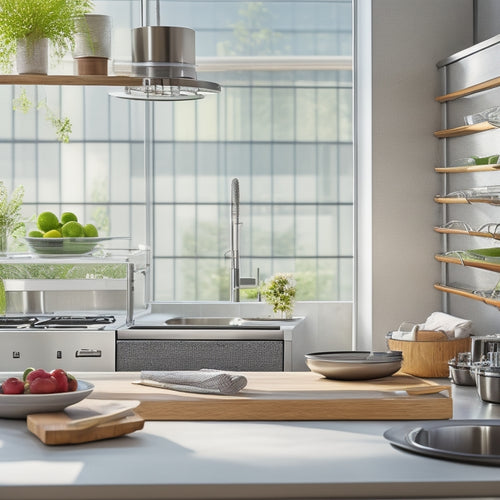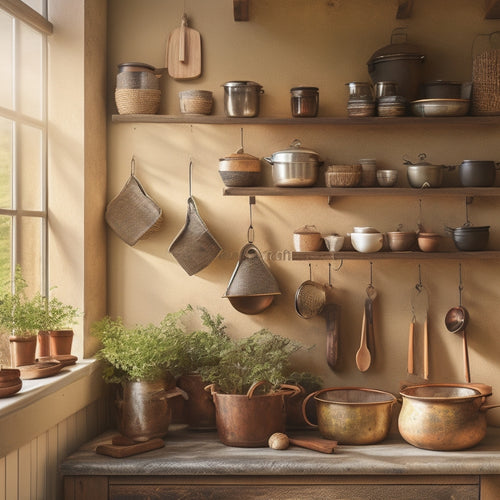
Home Freeze Dryers: Mastering the Process
Share
To master the process of home freeze drying, it is essential to understand the intricacies of transforming fresh food into a lightweight, nutrient-rich, and shelf-stable product. Preparation involves selecting foods with high water content, arranging them in a single layer, and ensuring proper equipment setup. The freeze-drying process involves pre-chilling, freezing, and drying, requiring consistent temperature maintenance and precise control of pressure and humidity. Effective monitoring and controlling, proper packaging and storage, and regular maintenance are vital for best results. By grasping these fundamental principles, you will be well on your way to optimizing the full potential of home freeze drying.
Key Takeaways
• Select foods with high water content and arrange them in a single layer on trays to ensure efficient freeze drying.
• Pre-cool the freeze dryer to the recommended temperature and maintain consistent temperature control to prevent nutrient degradation.
• Monitor temperature, pressure, and humidity levels to regulate water removal and prevent rehydration during the drying process.
• Use proper packaging materials, such as Mylar bags with oxygen absorbers, to maintain food quality and prevent oxidation during storage.
• Regularly clean, inspect, and maintain the freeze dryer equipment to ensure longevity and optimal performance.
Preparing for Freeze Drying
Before beginning the freeze drying process, it is important to properly prepare the food and the freeze dryer to achieve the best outcomes. Food selection is critical, as not all foods are suitable for freeze drying. Choose foods with high water content and arrange them on trays in a single layer, without stacking, to guarantee even drying.
Equipment setup is also crucial, as incorrect temperature control can lead to inconsistent outcomes. Pre-cool the freeze dryer to the recommended temperature, and make certain all components are correctly assembled. Proper tray arrangement and equipment setup are necessary for efficient freeze drying and optimal food preservation.
The Freeze Drying Process
The freeze drying process commences with the freezing stage. Food is pre-chilled to a temperature of around -30°C to -50°C, rendering the water molecules immobile and preparing the food for the subsequent dehydration phase. This stage is essential in achieving ideal temperatures, which vary depending on the type of food being freeze-dried.
During this phase, it is crucial to maintain a consistent temperature to ensure uniform freezing and prevent the formation of ice crystals, which can impact the quality of the final product.
Once frozen, the food is then shifted to the drying phase, where the water content is gradually reduced, resulting in a crunchy and lightweight product. By mastering the freeze drying process, users can experiment with various recipe variations, accessing a world of possibilities in food preservation.
Monitoring and Controlling
During the freeze-drying process, precise monitoring and control of temperature, pressure, and humidity are crucial to achieve the finest results and prevent spoilage.
To guarantee peak conditions, it is essential to:
-
Monitor temperature: Control temperature fluctuations to prevent degradation of nutrients and texture.
-
Regulate pressure: Maintain optimal pressure levels to facilitate efficient water removal.
-
Conduct moisture monitoring: Track moisture levels to determine when the drying process is complete.
- Maintain humidity control: Prevent rehydration by controlling humidity levels during storage.
Packaging and Storage
Proper packaging and storage of freeze-dried foods are critical to maintaining product quality and shelf life. To guarantee long-term preservation and food safety, it is essential to use suitable packaging materials and techniques.
| Packaging Method | Description |
|---|---|
| Mylar Bags | Use with oxygen absorbers to prevent moisture and spoilage |
| Canning Jars | Ideal for dry goods, securing an airtight seal and protection |
| Vacuum Sealing | Eliminate air to prevent oxidation and spoilage |
Creative packaging ideas can also be used to make thoughtful gifts. Consider using decorative jars or bags with personalized labels. Always store packaged foods in a cool, dry place to maintain their quality and shelf life. Remember to follow proper storage guidelines to guarantee the safety and longevity of your freeze-dried foods.
Post-Processing and Maintenance
After completing the freeze-drying cycle, several post-processing and maintenance tasks are vital to guarantee the longevity of the freeze dryer and the quality of the resulting products.
To secure continued performance and safety, it is important to perform the following tasks:
-
Clean the equipment: Thoroughly clean the freeze dryer, including the chamber, shelves, and vacuum system, to prevent contamination and maintain hygiene.
-
Perform equipment maintenance: Regularly inspect and maintain the freeze dryer's components, such as the vacuum pump and refrigeration system, to prevent malfunctions.
-
Check and replace worn parts: Identify and replace worn or damaged parts, such as seals and gaskets, to maintain the freeze dryer's integrity.
- Update software and firmware: Regularly update the freeze dryer's software and firmware to secure access to the latest features and improvements.
Frequently Asked Questions
Can I Freeze Dry Cooked or Raw Meat With Bones?
When freeze drying meat, it is recommended to use boneless, raw or cooked meat to guarantee food safety and best results. Freeze drying fruits and vegetables is a more straightforward process, requiring minimal preparation.
How Do I Prevent Freezer Burn Before Freeze Drying?
To prevent freezer burn, employ the guardian of freshness, vacuum sealing, to shield your meat from oxygen's ravaging effects. Remove bones to prevent moisture accumulation, and freeze at 0°F (-18°C) or below to preserve texture and flavor.
Can I Use Glass Containers Instead of Mylar Bags for Storage?
When considering storage options, glass containers are not recommended for freeze-dried food due to potential moisture entry and oxidation. Mylar bags, with their impermeable material and oxygen absorbers, provide superior protection and preservation advantages for long-term storage.
Is It Necessary to Clean the Freeze Dryer After Each Use?
The irony: a pristine freeze-dried meal spoiled by residual contaminants in the unit. To avoid this, clean the freeze dryer after each use with gentle cleaning materials, ensuring maintenance frequency that prioritizes food safety and peak performance.
Can I Freeze Dry Food Past Its Expiration Date?
When freeze drying food past its expiration date, exercise caution. Freeze drying fruits and vegetables may be acceptable, but expired dairy products may spoil or pose health risks. Always prioritize food safety and handling guidelines to guarantee secure consumption.
Related Posts
-

Top-Rated Dish Drainers for Kitchen Use
Top-rated dish drainers enhance your kitchen's efficiency and aesthetics. You'll find compact designs that save preci...
-

Ceiling-Mounted Pot Racks for Professional Chefs
Ceiling-mounted pot racks are revolutionary for professional chefs like you. They make use of vertical space, keeping...
-

Wall-Mounted Racks for Kitchen Tool Storage
Wall-mounted racks are perfect for maximizing storage in your kitchen. By utilizing vertical space, you can free up u...


